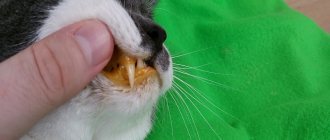The character of a cat is formed in the womb at the genetic level. If the kitten’s mother was kind and gentle, then there is a high chance that the baby will inherit the same character traits. In addition, the fact that the kitten communicates not only with a caring mother cat, but also with its father, during the first 1-2 months is also important. The atmosphere of raising a baby at this time leaves its mark on his future life. Don't forget about social adaptation. Kittens, who were caressed by human hands in childhood, grew up in love and harmony - with an accuracy of 99%, in the future they will be filled with love for the world around them and people. But what to do if you don’t know all the details of the first days of a kitten’s life? Perhaps you even found him on the street and decided to shelter him? There are a couple of effective methods that will help you raise an affectionate cat or try to re-educate an already adult and unapproachable cat.
How to tame a wild kitten
Future owners are worried: how to tame a kitten, what if the situation gets out of control and an unaffectionate cat will grow out of a cute creature. The baby quickly gets used to it and begins to understand:
- Where is the toilet.
- Where is the bowl of food?
- Who lives in the family, from whom you need to hide.
To tame a cat you will have to wait ten days (maximum). Usually this much time is spent on re-educating a street dweller.
It’s worth learning from the very beginning: a kitten’s squeak means “I feel bad,” while purring is a sign of goodwill and contentment.
There is no need to push a squeaking lump into a bathtub of water or allow children to cause pain. The kitten should feel safe and loved. It’s easy to accustom a kitten to handling and rules of behavior (both in the house and at an exhibition): affection, play and treats will do.
Once the baby is in the house, you need to give him time to calm down. You can leave him in an unlocked cage or put him in a low cat basket. Don't forget to place a bowl of water nearby.
In a calm environment, the kitten will soon crawl out of its shelter and go to inspect the territory of the house. Don't pick him up just yet. It is enough to gently stroke him and say a few words in a calm tone. Then transfer to a bowl and praise. In this case, the kitten in your hands will not perceive the action as danger.
Within 24 hours, the cat will begin to trust its owner and may jump onto its lap. The kitten will learn to sit quietly in your arms if you support it by its back. The warmth of the hand is soothing, and any possible fear of heights disappears.
This is interesting: A cat with long legs
Why does a cat refuse to be held?
In most cases, owners of cats picked up on the street face a similar problem. In this case, the pet’s behavior is understandable - he simply does not trust people. It’s worth waiting a little until the cat gets used to it, takes a closer look at the new environment and learns to trust the members of the household. It is more difficult to understand a cat that came into a family from a nursery as a kitten, but after a certain time still does not want to sit in your arms.
Possible reasons:
- The cat is just uncomfortable . The animal should be picked up in such a way that there is a support point and movements are not constrained. The best option is one hand under the chest, the other supporting under the hind legs.
- The pet is afraid of heights . This may sound funny, but often among representatives of the cat world there are specimens that are afraid of heights. If the cat begins to panic when being held, you need to squat down. This will allow the pet to feel more confident.
- Memories . Cats have phenomenal memories. If, as a kitten, your pet slips from your hands and falls, he will remember this for the rest of his life.
- Repulsive odors . Unpleasant, pungent odors for cats that come from human clothing, for example, alcohol, eau de toilette, soap or shower gel, can cause reluctance to touch.
Another reason is that cats simply do not like affection. These animals prefer to lead a solitary lifestyle, avoiding contact with people as much as possible. The owner can only get used to this state of affairs.
Reasons for behavior change
If a previously affectionate cat has stopped making contact with her owner or has become aggressive, then most likely something is bothering her. The most common reasons for changes in animal behavior :
- disease;
- puberty;
- stress;
- poor care;
- age.
© shutterstock
If you correctly understand the cause and eliminate it, the cat will become habitually affectionate.
The cat is sick
Poor health greatly affects the character of the pet. A sick cat, who only yesterday loved affection, today may hide from its owner or even attack him. By its behavior, the animal shows that something is bothering it.
Show the animal to the cat doctor - veterinarian. After examination and examination, he will be able to determine whether the animal is healthy and, if necessary, prescribe treatment. Follow all the recommendations and your pet will quickly recover. After a complete recovery, the pet will be the same as it was before the illness.
The kitten has grown up
The kitten grows up and, under the influence of hormones, its character begins to change. Marks appear in the house, and the animal may even try to escape in search of a member of the opposite sex. Often the cat becomes aggressive and may scratch or bite the owner. Behavior does not depend on whether the animal is allowed outside or not. Some owners believe that if they take the cat to mating, he will become calmer, but this is fundamentally wrong, the situation will only get worse.
The only solution is castration. After the operation, the cat will become as affectionate as before . The animal will be calmer and will happily begin to spend time with its owner.
Stress
In an unfamiliar environment, the animal behaves warily and sometimes aggressively. Moving to a new home or acquiring a new pet disrupts the cat’s usual way of life. Also, your pets will not be happy about vacation trips or moving to the garden for the summer.
© shutterstock
After adaptation, which lasts about 3 weeks, the cat will become affectionate again. In order to facilitate this process, you can give your pet calming tablets, which are sold in pet stores. Most likely, the cat will not be affectionate until the adaptation is complete.
Poor animal care
Poor grooming of a cat can make it unkind. A hungry animal becomes irritable. Therefore, it is important to give the animal high-quality, healthy food that contains all the necessary vitamins and microelements. A dirty litter box can also irritate your cat, so either clean the litter box immediately after use or buy an absorbent litter.
The animal must not be beaten or shouted at. A frightened cat will not be affectionate because it is afraid of its owner. Communication should be friendly, pamper the animal with treats more often and play with it. A satisfied cat will be affectionate with its owner and will enjoy spending time with him.
Causes of aggression in cats
When getting a cat, many people think that when they come home, their beloved pet immediately runs and sits in the arms of its owner. He begins to purr affectionately and waits to be petted. But sometimes there are cases when an animal simply hates it when people start playing with it. Cats become very aggressive and uncontrollable. The reason for this behavior may be the smell of the owner, as well as the poor health of the pet. They may not be able to be handled and begin to bite and scratch heavily.
Cats are independent and freedom-loving animals by nature, who adore affection, and spend time with their owner with great pleasure. But sometimes a pet can be in an aggressive state, they begin to bite hard, and can show their claws. The reason for this behavior may be the poor health of the animal itself. Sometimes the kitten is still small, it is difficult for him to sit in one place, he wants to run around the house, and when you start to forbid him to do something, to pick him up, this leads to strong aggression.
The breed of a cat affects its character
Some cats are not affectionate from birth, but they can be made more friendly. There are factors that influence the behavior of an animal. The first importance here is the breed: a British cat most likely will not want to sit on your hands, since he has an independent character.
In order to make your cat more affectionate, pamper her, spend time with her, play, then she will purr more often and will begin to seek communication on her own..
Previous
Questions and Answers Why cats purr - reasons and how they do it
Next
Questions and Answers How to raise an affectionate and obedient kitten
Making a cat's face (first option)
Master class “How to make a cat out of paper”: making a face using the first method:
- Place a square sheet of paper in front of you (Illustration 1).
- Fold the top right and bottom left corners together. The result will be a triangle (Figure 2).
- Fold the left corner of the triangle down so that its tip is flush with the bottom, but not touching it (as in Illustration 3).
- Fold the right corner in the same way as the left (Illustration 4).
- Fold the middle corner up slightly, as in illustration 5.
- Turn the figure over.
- Draw the eyes, nose, mouth and antennae (Illustration 6). You can also add eyebrows.
The cat's face is ready!
Restricted areas
If your pet comes up to you to rub against your legs, do not yank him to pick him up. Remember, cats do not like to be deprived of their freedom and treated like a doll. Just gently call the cat to your sofa for petting. If she wants, she will come, and then you can caress her. But not all places on a cat’s body crave these caresses. There are areas, touching which alarms the animal and instinctively provokes it into aggression or escape. These areas include:
It is best to observe the cat’s reaction to your touch; over time, you yourself will understand which places it is better not to touch, and in which areas it is better to double the portion of strokes.
Anticipate events
An example: the owner is going to train the kitten to use the litter box. To do this, he bought an expensive, comfortable and beautiful tray, poured filler into it and even held the kitten three times until the “victory end”.
And then the owner comes home from work, and all the waste products of the pet are anywhere but in the tray. What does the owner do? Of course he punishes. And this seems quite natural to people.
- But the kitten is not a person, and for him it looks completely different. He was waiting for the owner, sincerely rejoiced at his arrival, ran to meet him, and he, instead of scratching behind his ear, began to scream, grabbed him, and even punished him. Next time the baby will be afraid of the owner's arrival. And later it will become completely uncontrollable.
- But what should be done? Just create conditions under which the baby doesn’t want to do anything dirty. Is the sofa tearing up? Spray the furniture with a special product that repels cats with its smell.
- There are some on sale now. Humans cannot smell this smell, but cats find it unpleasant. This type of spray is used to wean moustaches from relieving themselves in the wrong place.
If you can’t find such a product on sale, you can always use a sprayer for home flowers. You see that the kitten has approached the sofa and is aiming to clean its claws, so spray water on it. If you do this every time, very soon the baby will understand that there is no need to do this.
Moreover, it is important to remember that you cannot break your rules. You can’t prohibit a kitten from climbing on the table today and give up on it tomorrow. It’s impossible today, which means it’s impossible always.
How to catch a wild kitten that is afraid of people
Although caring for a cat takes less effort than caring for a dog, adopting an outdoor cat is a big responsibility. It’s a pity for the little lump, scared and frozen, squeaking near the trash can or the entrance door. He will not scratch or bite if you put the kitten in your palm, stroke it, and mutter a few gentle soothing words. The warmth of human hands for a baby is a guarantee of food and safety.
Please note that we are talking only about feral and street cats, whose ancestors have always lived with humans. The real wild cats, which can only be tamed by Yuri Kuklachev and the Zapashny brothers, are:
- Jungle Cat (House);
- European forest cat;
- Amur (Far Eastern) cat - inherits aggression towards humans and fear.
For an outdoor wild cat or kitten from the street, a visit to the veterinarian is mandatory, as it can be a carrier of viruses and infections that are dangerous to the health of humans or other animals in the house.
The newborn was probably thrown out by people: no hand was raised to drown or poison. Opening her eyes, the baby captured the person as a relative. Therefore, he does not experience aggression towards people. It’s easy to domesticate this one: it will get used to its new home and fall in love with its new owner in an evening.
Imprinting (instant early memory) of kittens that were born and lived in an attic or basement for a couple of months does not apply to humans. Stray cat cubs can remain feral for life.
The little “animals” run away, and when you try to pick them up, they bite. To catch a wild cat, use primitive traps:
- large box;
- baby bath;
- a rabbit cage without a bottom;
- regular carry...
They put food on the ground and cover it, for example, with a box.
Important. Consider the size of the animal. A heavy container falling on its back can injure the cat.
All that remains is to lift it and place one side on a support with a rope. As soon as the animal approaches the food, the stick is pulled out.
A more complex option: a cage with a lowered door (kotolovka). Triangular-shaped nets with a long handle and noose loops are also used.
To catch a domestic yard kitten, it is enough to regularly feed it by hand and talk to it. In a couple of days the baby will come running when called and allow himself to be petted.
When thinking about how to tame a cat, a person forgets: the cat chooses the owner. It was the cat who first began to meow, demanding food and attention, rubbing against her legs, showing affection. Once in the apartment, the animal adapts to the rhythm of the owner, giving him special, cat-like care.
This is interesting: Why doesn't the cat let the cat near?
Spray bait
Sometimes a cat must be accustomed to being handled using a special bait spray, which is sold in a pharmacy and usually contains catnip extract; this is necessary in cases where the kitten has been running wild for a long time and categorically refuses to make contact. Most often, this phenomenon is observed if the animal has suffered from people and because of this cannot help but fear even its owner, who loves it and has created comfortable living conditions for it. Also, basement kittens, which have largely returned to the behavior of their wild ancestors, are often distinguished by distrust.
The spray should be applied not to clothes, but to the palms of the hands, so that the kitten gets used to the person, and not to the thing. The smell of the product acts on the animal like a drug, and therefore the pet will, despite its fear, still run to the owner and rub against the hands. Gradually, the kitten will understand that there is nothing dangerous or unpleasant when communicating with a person. As a result of this, in the future, even without a spray, the pet will be willing to be handled.
When using a spray, it is important not to exceed the norm so that the baby does not become accustomed to it and begins to suffer from the lack of the drug. Because of this, you cannot use the product more often than once a day. This remedy should be used more often if you had to take an adult cat into your home.
How to accustom a cat to hands and affection
If you want cat affection, become patient and affectionate yourself. An outdoor cat will begin to trust a person when it gets used to his smell and voice. He will associate his appearance with a pleasant event (food, affection).
A wild cat is tamed in the same way as a kitten. First, treats are brought regularly. Then they hold out their palm with a piece of the most delicious thing (the delicacy lies in the center of the palm, not on the fingers!), and allow it to be sniffed. When the cat begins to approach, perhaps rubs its head on its leg, you can pet it in response, speaking calmly and affectionately.
A common mistake: in order to tame a cat at home, he is immediately locked in a room - the animal will try to escape as soon as it is freed.
You can call the cat with you, after a few meters, stop, praise, and give a treat again. The main thing is that if you come, give her the opportunity to leave. Without feeling afraid, the pet will return.
How to train to the tray
If the example of litter box training was given above, then it is worth understanding this issue in more detail. Moreover, visiting the toilet is one of the basic rules for a cat living with a person.
- If a kitten is taken from a conscientious breeder, then the baby, as a rule, has already learned to wear a diaper.
- If the kitten did not have a breeder, it is not difficult to train it yourself.
- To do this, disposable diapers are laid out throughout the room.
- Throughout the room so that the baby does not have to search for a long time or run to the right place when he needs it.
- And then you need to observe. Before making a puddle, the baby begins to worry - look for something, spin around himself.
- At this time, you need to quickly put him on a diaper (or immediately in the tray), and hold him there and stroke him.
- After the baby has done his business, he needs to be praised, you can even give him a treat.
It is important to remember not to grab the kitten when you see him looking for a place. And you can’t scream with delight after a successful visit to the tray either. Don't scare the child. Movements should not be panicky, but calm.
Everyone understands this, but, more often than not, it turns out the other way around - they grab the baby, drag him somewhere running, and as a result, the little kitten gets scared and is not going to do anything at all. Tolerates. It seems to him that making a puddle is something terrible, scary and he needs to postpone it.
- Endure until the last. That is why the picture is often observed - the owner definitely saw that the kitten was settling in, but in the tray he immediately lost all desire. And it’s not the baby himself who is to blame, but the owner.
- If the kitten has learned to wear a diaper, you need to gradually reduce the number of diapers laid out and move them to the place where the tray is located.
Later, all the parts of the diaper with the smell just need to be laid out in the tray. If the owner does not make mistakes, the kitten will quickly understand what is required of him.
Why is the cat not affectionate?
If a cat scratches and bites as an adult, the owners themselves are to blame. While still playing with her, they allowed her to “claw” in excitement. At first it's funny, then the adult:
- bites legs;
- does not allow himself to be combed;
- spoils things, marks territory.
The simplest veterinary examination and medical procedures (injections, enemas) turn into a nightmare for the owner.
The independence and aggressiveness of a mustachioed cohabitant should not be shown towards family members. If the owners are afraid, the pet will become impudent. It is recommended to hold the cat in your arms more often and show affection. After taming, release it for further exploration of the area, praise and treat it with something tasty for good behavior.
Gradually the cat will understand: nothing bad is happening. If you do this regularly, at the same time talk affectionately, give a piece of “yummy” - after a while you can add short-term combing, examining the ears and other manipulations.
An irrepressible desire to “cuddle” can also be the reason why a cat becomes less affectionate. Small children will happily play with the kitty and pull its ear or tail.
Adults sometimes don’t lag behind (especially if the cat is not their property): they shamelessly shove pieces from the table, try to stroke them and pick them up against their will. It's not the cat that needs to be blamed, but the owner:
- If the cat is not the highlight of the program, it is better to isolate it in another room. Or warn the guest about correct behavior.
- For children, it is better to find other fun, otherwise the simplest scratch on the hand of an uncontrollable child will ruin the evening.
- When neither the person nor the cat is particularly anxious, let them interact as they wish.
Advice. It is advisable to wash your hands not only after interacting with an animal, but also before. Precautionary measures apply to small unvaccinated kittens.
The selection of some breeds followed the path of consolidating external characteristics. Such cats are more attached to the territory than to the owner. For example, bobtails and Norwegian forest cats do not recognize excessive affection.
It is better to choose a Burmese, Siamese, Sphynx or Rex or an ordinary yard cat - a “mongrel”. “Human-dependent” cats can hardly tolerate loneliness, they are easy to tame and they love the affection of their owner.
How to make a cat affectionate?
Felinologists say that a very affectionate cat is a well-fed cat. There is no question of feeding your pet, but if your animal is starving, you won’t get any affection from it. Do not interfere with the food process under any circumstances; this is an intimate process for a cat (and for any creature, in principle). There is no need to feed the animal if your kitchen is crowded, noisy and loud.
- A very affectionate cat is an animal that receives a lot of attention. If you brush your pet off, if you are not ready to pet him again, if you don’t bother talking to the cat, then don’t expect a response. Cuddle, watch TV together, read the newspaper together - take breaks with your cat.
- To make an animal tame, you cannot carry it in your arms. It's paradoxical, but it's true. You want to pet the cute little kitten and take him in your arms, but why? He doesn’t need it, he loves distance, and if he wants attention, he will definitely show it. By picking him up again, you limit his movements - the cat won’t like it. If you take a cat in your arms, do it in such a way that it has the opportunity to leave at any moment: one hand under the chest, the other stroking the animal.
- The animal escapes danger by climbing to a height. It is unlikely that you will be able to plant a tree at home, but you can organize different houses and higher ladders. In case of stress, the cat will climb there, feeling safe. This means there will be less stress when he has a shelter.
- Games are more important than toys. To make a kitten affectionate, it is not enough to buy him bright springs and glowing balls. You need to play with him, have fun, and involve all household members in playful contact with the baby. By playing together, you begin to understand each other, and that very possible closeness between man and animal is formed.
- Taboo is your hands or feet as a toy. As soon as you start tapping your fingers or twitching your leg, the cat turns on the hunter and attacks. Prepare for constant scratches. In this sense, you cannot evoke a wild animal in a cat. But if in the heat of the game the cat does attack you, do not pull your hand out. Freeze, look at the naughty boy without any smile, you can even hiss - he will let go of his hand himself. And probably won't attack again.
Is it possible to tame an adult cat to a new owner?
A cat tolerates a change of owner more easily than a dog. The exception is socially oriented breeds, for example, Oriental Siamese. They will gradually become affectionate with their new owners, but the first one is the only one for life.
The best way to train, even for a sexually mature individual, is not food, but play. First, an adult cat must get used to the territory. It is better to leave your pet to explore its new home on its own, and after a while offer some food from your hands. Just like a treat. At the same time, do not forget to talk measuredly, but not to stroke.
As soon as the cat gets used to it a little, you can:
- lightly scratch a chair or furniture - so that the cat reacts to the sound near the owner;
- roll a ball or ball of wool near you, inviting you to play;
- “drive” a candy wrapper.
The cat quickly joins the game. After a while, you should again give a piece of food from your hand and praise it.
What to do with existing parenting flaws
What to do if there are mistakes and flaws in raising a kitten? You can try to fix them. Of course, this is a more complex process than initially properly raising an animal, but it is possible. Let's look at the most common errors:
- Goes to the toilet in the wrong place
- you shouldn’t scold or hit the kitten. It is important to show him his territory, choose the right tray and filler. If the kitten has chosen a specific place to relieve itself, you can temporarily place a tray there until the baby gets used to going in it (how to accustom a kitten to the tray). - It spoils, tears and gnaws curtains
, bedspreads and other things - this habit must not be allowed to develop; to wean it off, you can use a spray bottle of water; at the slightest intention to spoil the thing, you must spray the mischief-maker and stop his intentions constantly until he loses the desire to do it. . - Sharpens its claws on furniture and carpets
- often such actions are caused by natural instinct, this is how cats mark their territory. To stop this, it is important to purchase several scratching posts and immediately accustom the kitten to them. It is also important to trim your pet's claws on time. - He bites and scratches
- this must be weaned from childhood. To play, you need to use not your hands, but toys intended for this. If a baby bites and scratches and this cannot be stopped, then he will repeat the actions as an adult. To wean yourself from a bad habit, you can lightly flick the mischief-maker on the nose. In the same way, a mother cat punishes her baby. - Marks corners
- this problem often occurs in males. It is very upsetting and makes caring for your pet difficult. But don't despair. You need to spray the marks with a solution containing an essential oil with a strong odor, such as citrus. It will forever discourage the cat from marking corners.
Cats are one of the most popular pets. Very often, both adults and children dream of having a cute and playful cat live in their home.
However, before getting a kitten, you need to carefully study the information about your preferred cat breed, as well as the needs of your future pet. In order for a furry pet not to cause inconvenience, but to bring joy, it is necessary to raise it correctly.
Care and attention
Cats love to take care of themselves and each other. Try to become her best friend and use a special soft cat brush to gently comb her fur. If the pet is delighted, it will begin to lick itself. If the procedure begins to irritate the cat, its tail will twitch nervously, which means it’s time to finish these manipulations and move on to playing with candy wrappers (for example).
Grooming
Regular grooming is one of the ways to build a friendly relationship with your cat. Combing the fur with soft, gentle, rhythmic movements, accompanied by a quiet conversation in a gentle tone, calms the animal and helps it relieve stress.
But if your pet gets tired during the procedure and begins to twitch, the session should be stopped immediately.
Recommendations for raising cats
- Eye contact.
The cat family has a negative attitude towards staring and the manner of looking eye to eye. Pets regard such behavior as a challenge and preparation for an attack. Regardless of your cat's age, do not supervise it closely. Observe your pet with peripheral vision without giving yourself away. If you are looking at a cat directly, blink smoothly and frequently, and do not keep your eyes open all the time. After time, your pet will appreciate the changes in your behavior and will want more attention. - Proper care.
A cat will grow up affectionate and loving only if it receives the necessary care from its owner. By nature, four-legged friends take care of each other. Your pet expects the same from you. The cat will appreciate the actions associated with slowly stroking its fur and scratching its neck area. Buy a comb, take care of the animal’s fur, while at the same time saying affectionate words in a quiet voice. If you notice a twitching of the tail, this means that the cat is tired of being handled. Reschedule procedures for another time. Purring and stretching will tell you that the pet is happy. - Treating yourself with a treat.
Make it a habit to carry a robe in your pocket and keep cat treats on hand. You can purchase a package of treats at a pet store or use homemade products based on your pet’s preferences. When the cat approaches you, give it a treat. Over time, the pet will get used to such actions and will be glad to be nearby. Give out double treats if your cat jumps into your arms. - Stroking.
When a cat gets used to the owner, his care, constant feeding of treats, display of restraint and patience, she is around more and more often. Be patient and monitor the animal's behavior. If your ward lies down next to you, placing her back or neck under your arm, do not skimp on stroking. With light movements, satisfy your pet's needs. At the slightest sign of dissatisfaction, stop manipulation. Affection should be in moderation. - Calmness and restraint.
If you recently brought a kitten into your home, adjust your behavior. Animals of this kind are afraid of sudden movements and loud sounds, especially if the person and the area are unfamiliar to them. Let the pet get used to its owner. Move smoothly, speak kindly and calmly. If possible, stay close to the cat as often as possible; it is not necessary to pick it up. Let the kitten come to you for a portion of tenderness and attention. - The direction of affection.
The cat family takes a long and persistent journey to begin to trust its owner. Many owners fail to achieve this even after 2-3 years of living together with their pet. If you are not one of them, having successfully made friends with your pet, follow the recommendations. When a cat comes to you for a portion of tenderness, you don’t need to grab it in your arms and pull it. Sit down next to him, scratch your tummy, neck, back. Let your pet rub its muzzle against you, stroke the bridge of its nose. Do not touch the cat in places where it is uncomfortable (paws, tail).
how to train a cat at home
How to correct parenting mistakes?
Cats, like people, experience many emotions that influence their behavior. Some animal actions are considered undesirable and can affect the atmosphere in the home and the relationship between owners and pet. Fortunately, many behavior problems can be corrected.
Let's look at how to raise a cat when it "violates discipline" in the house. Maybe she wants to say something? Maybe something is bothering her?
The cat screams at night
If we exclude health problems, natural instincts and cat old age, this behavior is completely normal for an animal, it is inherent in nature. Night cries are characteristic of Siamese cats, so they attract attention. They may be bored or suddenly want to eat.
Why does the cat scream at night?
Cats usually spend their days idly, especially when no one is home. Find an opportunity to prevent your animal from sleeping during the daytime. Sometimes the owners follow the lead of the cunning people and feed them in the middle of the night, just so that they calm down. So, the pet develops an understanding: if you scream, you will get what you want. Do not succumb to cat provocations, endure this period. When the cat understands that she will not get attention, she will calm down.
Let's stop scratching
Cats scratch objects because they sharpen their claws and mark their territory. Teach your pet to use a scratching post. Choose a scratching post from different materials. To attract attention to the item, you can spray special flavors based on catnip.
Cat scratching post
Observe whether the cat likes the material of the scratching post. Perhaps your carpets are more comfortable for her? Then give your pet his own rug. And if the pet has chosen a certain place, for example, the armrest of a sofa, upholstery made of sisal or other clinging material will help protect the furniture.
Use furniture protectors in areas where your cat likes to sharpen his claws.
If the active scratching is caused by anxiety or stress, reassure your cat. Pheromones are available in pet stores in the form of diffusers with a proven calming effect.
Calming pheromones
An unusual, but at the same time effective way to protect wallpaper, curtains and furniture are claw caps. They come in various sizes and colors, are glued with special glue, and do not interfere with the animal’s movement and play. At first, the cat will be dissatisfied with the fact that foreign objects are glued to it, but soon it will get used to it and will not notice them. Do not use caps if your cat has paw problems, a fungal infection, or a split nail structure.
Claw caps
Anti-gnaw and anti-scratch sprays repel animals. The components they contain are unpleasant to cats. You can prepare a similar spray yourself by dissolving ground pepper in water and spraying furniture with this solution. The disadvantage of this method is that it only works until the smell disappears. Sprays will have to be used every two hours. In addition, many active cats are completely indifferent to any odors.
Anti-scratch spray
Trim your nails often. This will cause cats to cause less damage and scratch less often. Use special nail clippers. Nail scissors destroy the structure of the claw, after which it delaminates. Nails should be trimmed every two weeks.
Cat claw clipper
How to trim a cat's claws
Water repels cats. Spray water on your pet when he is looting. Use scaring sounds. A long “Pshhh” will let the cat know that the owner is unhappy.
If the cat is active and loves to play, take part in this, use balls and toys that can be scratched. The cat must throw out the accumulated energy. After games she becomes calmer.
Cat toy with catnip
Training the cat to use the litter box
What to do if your cat goes to the toilet in the wrong place?
Difficulties with the toilet in an adult animal are possible due to health problems. Urinating in the wrong place, straining when going to the toilet indicate serious deviations in the pet’s well-being. These may be infections, inflammation, bladder stones, stress and other factors. Conflicts between animals, if there is more than one cat in the family, strangers in the house, or a long absence of the owner can cause anxiety in the pet and lead to disorders of the urinary system.
If you exclude all medical problems, behavioral problems remain. You need to find out why your cat is ignoring the litter box and then find a solution.
Is the tray cleaned often enough? Cats are picky about toilets and do not want to put up with neglect. They also love consistency. If you change the location of the tray or the tray itself, your pet may not accept this state of affairs. Sometimes the place where the tray is placed seems unsafe to the cat. Choose locations away from doors, where the animal can observe the situation around it. It is advisable for the tray to stand in a corner, surrounded on both sides by the walls of the room. The shape of the tray also matters. For some animals, the simpler the better. Any additions can be intimidating. Others love privacy and will not give up walls and a roof in their small closet.
Toilet tray
For what other reasons did the cat stop going to the litter box? It happens that the pet does not like the filler. It may be sharp, emit an odor unattractive to the animal, and stick strongly to the paws. Try other types of fillers and observe the reaction. If you have a cat who previously lived outside, he will be more familiar with dirt or sand.
If you have an adult cat at home who is not trained to use the litter box, try training him. If you see that the animal is acting restless and looking for a secluded place, immediately place it in the tray. Do this every time after eating. Use your paw to dig into the litter as cats usually do.
Training the cat to use the litter box
If your cat defecates in a certain place that is not intended for this, try limiting access there. Place an object in this place. If the place is hard to reach, cover the road to it with double-sided tape; cats don’t like to stick. Spray the area with lemon juice. The smell of lemon is pleasant to humans, but not to cats. Also, the smells of other citrus fruits, lavender, table vinegar, and black pepper are unpleasant for the cat.
The smell of lemon repels cats
Soak a napkin in the cat's urine and place the napkin in the tray. The smell will attract your pet. For the same purposes, special sprays are used, which can be purchased at pet stores. But many cats do not react to such odors.
Manufacturers of pet products offer various repellents designed to repel cats when they visit inappropriate places. These include sprays, which were mentioned earlier, ultrasonic and water repellers with motion sensors, and repellent rugs.
Ultrasonic repellents are highly effective, but are not safe for the psychological health of cats. The device affects the animal, producing an unpleasant sound. Because of this, the cat experiences stress and constant pressure. A person cannot hear such a repellent, because the sound is outside the range of human hearing.
Ultrasonic repeller
Such devices are convenient in personal plots where the appearance of neighboring pets and wild animals on the territory is undesirable. The disadvantage is the high cost, and water repellers use, in addition to electricity and battery power, water from a hose.
Water repeller
A treat in your pocket
It wouldn’t be bad if you always had a piece of something tasty for your cat in your robe. So that at the moment when your pet cuddles up to you, you can thank her and treat her. Well, if she went further and jumped into your arms, continuing to purr, then the portion of the bribe can be doubled. It is important at such moments to maintain calm, without showing violent delight. Do not wave your arms and speak quietly so as not to scare the animal.
Another option for a soft toy
It is aromatic and delicious thanks to catnip, an aromatic and flavoring additive. Cats love to chew on these devices. Time spent with a mint toy is not just a game, but also the prevention of caries. The product has a structure that removes plaque—soft and hard—from the teeth of a domestic predator.
Delicious and aromatic “Mint Leaf”
Continuing the theme of soft toys for cats, it is worth paying attention to the puppet toy.
To make it you will need:
- an ordinary soft toy (you can also use the options that were shown in the master classes above);
- stick (or regular pencil);
- glue.
Toys on sticks
You need to cut a small hole at the bottom of the soft toy.
It should correspond in size to the diameter of the stick.
If filler comes out of the toy, the excess should be removed.
The animal should not be allowed to try to swallow the filler.
Next, apply a drop of glue to the tip of a stick or pencil and place it inside the toy.
It is not advisable to use tape in this situation, as it is less secure and may pose a health hazard to the cat if it swallows it.
When the puppet is ready, you can call the cat and wave this toy in front of him.
An interested animal can pounce on her and pat her.
The main thing is that the pussy plays with the puppet under the supervision of the owners.
Original part
How not to behave around a cat
Cats are quite freedom-loving and touchy creatures. If the owner has ever offended the cat, the cat will never approach him again. And you can’t even dream of him jumping onto your lap. If the cat receives affection and attention from the owner, then gradually he will get used to the person and respond with mutual affection.
It should be remembered that cats will never do anything against their will. There is no need to forcefully hold them on your knees; this still will not lead to the desired result. The animal itself must want to sit or sleep on its owner’s lap.
If a small kitten tolerates the owner’s caresses normally, then at the first sign of anxiety, it should be released. When the animal begins to nervously beat its tail on the floor, it says that I’m tired, I have a lot of things to do.
Features of training purebred cats
To tame a purebred cat, you need to gain its trust. To this end, you need to create a clear daily routine: hours of feeding, games, rest. Consistency will help the pet get used to the person.
Experts recommend taming a purebred kitten by sleeping together. You can replace sleep by relaxing on the couch
It is important to try to establish physical contact between the animal and the owner. With active cats, this can be achieved through play.
The way to tame a Bengal cat is to play active games with it three times a day. During the game, a person should praise his pet and treat him with treats.
To establish interpersonal contact with an animal, you can teach it to walk outside on a leash. In an unfamiliar place, the pet's behavior will be aimed at obtaining protection from the owner. Getting used to street walks, the animal will understand that its owner is a source of security. This way, a purebred cat will develop trust in a person.
Who is the head in this house
Never humiliate a cat by pointing out its place in the house. They are by nature incapable of obeying and can only feel happy when they are on an equal footing with their household members. Screaming, beating and punishment will not help you in raising your pet. Give her freedom and let her be the mistress of the house. Only steely patience and methodical persuasion will help correct her behavior. But on the other hand, the cat will definitely thank you for your understanding with its tenderness and affection.
Congenital features
By nature, every cat is a proud and affectionate animal, obeying its owner only for practical reasons. Innate egoism lies in the response to the actions of the “big brother”. If his behavior is hostile, the baby, and then the adult, will be withdrawn and aggressive.
Practicality is manifested in the fact that the kitten will never perform manipulations that do not benefit it. Therefore, one of the methods of education is to portray any negative action in an unfavorable, useless light. Then it’s worth showing another, more attractive pastime.
The rules of upbringing and training were developed over the years of close attention to representatives of the furry kingdom. Here are the results of many years of work:
- Educational activities are initiated from the first day of joint stay in the apartment/house.
- Do not encourage the kitten's familiar attitude, show that you are the master of the situation here and demand that certain rules be followed.
- Taboo on aggressive behavior and the use of brute physical force.
- Do not intimidate your pet with loud screams or sudden movements of the limbs.
- A proud pet will not tolerate humiliation. If you poked your nose into his puddle, this will cause an outbreak of resentment and vendetta in the future.
- A kind attitude will help raise a kitten to be affectionate and tame.
- The cat's perception acutely senses your emotional state and voice accompaniment. Therefore, to indicate an error, a sharp “chopped” phrase is enough: “You can’t!”, “No!”, “Scram!”
- The mental abilities of cats are at a high level, but acquiring skills, habits and abilities will take time and effort.
Ways to train a kitten
Sometimes you can’t just calmly sit a kitten in your arms, because it gets scared and, even when it recognizes the person, continues to struggle. In order for a pet to be willingly given into the owner’s hands, it is necessary to accustom it to this, if it itself does not show a desire to actively make contact. As soon as the kitten realizes that communicating with the owner, when he takes him in his hands, brings him pleasure, the baby himself will strive to cuddle the person. Be sure to hold the kitten correctly, caress the pet and talk calmly to it. It’s very good if the cat starts playing while in your arms.
The kitten will quickly stop being afraid to be handled if you use one of the training methods below.
- Using the characteristics of animal physiology. After the kitten has eaten well, it begins to feel sleepy, since maximum energy is spent on digesting food. If the animal is warm and comfortable at this moment, it will begin to experience special pleasure. The owner may well provide the pet with the illusion that he is lying next to his mother if he picks up a well-fed, dozing kitten and cuddles him, but without squeezing. Gradually, the baby will get used to the fact that sitting in your arms is very pleasant and safe.
- Talk. Monotonous, affectionate conversation with the kitten gradually begins to relax it. At this moment, the owner has the opportunity to gently stroke the pet behind the ear or in the throat area. If the kitten reacted calmly to such affection, you need to place your palms on its sides. If the baby does not break free here, he is carefully picked up. When the kitten tries to escape, you should not restrain it by force. Such sessions must be repeated several times a day, until the baby agrees to stay on the owner’s lap.
- Lure with a treat. This method is most suitable for kittens who are particularly freedom-loving and cannot combine being held in their arms with pleasant sensations. Using a treat, the owner lures the pet onto his lap. While the kitten is eating the treat, you need to stroke it on the back, but under no circumstances hold it by force. Gradually, the baby will get used to the fact that it is pleasant to be held and will actively seek the company of the owner.
- Overcoming the fear of heights. As strange as it may sound, some cats are terrified of heights. Because of this, when a kitten is picked up incorrectly and he perceives what is happening as floating in the air, he experiences a severe shock. This phenomenon can be prevented simply by starting to hold the baby correctly. Then his fear of hands will go away. You need to take the kitten with one hand under the armpits, and place the other under its hind legs. After this, the baby should be held close to you, but not squeezed. If the fear is panicky, then first you need to accustom the kitten to your hands while sitting on the floor.
- Training in the game. This method is suitable for active kittens who are not yet ready to exchange free time for affection. When playing with such a baby with a toy, you should gradually pull it onto your lap. After the kitten jumps into your arms, you need to let him catch the toy here and enjoy the catch. While the kitten is playing in your arms, you can pet it. Gradually, such games with jumping into hands will lead to the fact that the animal will not only completely get used to the hands, but will not be able to do without affection and close contact with a person. With this nature of the pet, you should often allow the cat to sit in your arms while playing with the owner.
The choice of method depends on the individual characteristics of the kitten, and each owner must evaluate for himself which method is optimal in his case. In principle, accustoming a kitten to affection cannot fail, you just don’t need to stubbornly follow a method that is not suitable, but need to be creative in your approach.
Does a British cat not sit on your hands because of its origin?
I will lie anywhere, but not sit in your arms
Perhaps the British dislike for excessive affection lies in the history of the origin of this breed. There are several versions about this:
- Large gray cats with amber eyes were brought to the British Isles by the ancient Romans.
- French sailors acquired huge gray cats from the monks of Grand Chartres to protect food cargo on ships from rodents. Their ships regularly visited the shores of Britain. Therefore, some cats could remain on the shore.
- The breed of British cats with wide cheekbones, large expressive eyes and thick short hair was formed as a result of crossing immigrants with local tabby wild cats.
Independent character of British cats
British cats have their own, independent and different character
Judging by the history of the origin of this breed, it can be argued that the independent character of the British comes from the harsh life on French ships, where none of the sailors coddled with them. Life among ascetic monks and proud Romans also left its mark on the independent character of these cats.
For centuries, their role was to live among people, mind their own business and earn their basic food.
Wild cat Tabby
Characteristics of a British cat
British cats are distinguished by their intelligence and intelligence. If handled skillfully, they can even be trained. However, adapting their behavior to the mood of their owner, representatives of this breed under no circumstances lose their dignity.
For these cats, freedom and independence are a priority
These qualities are more developed in British cats than others. Despite the centuries-old history of the existence of this breed next to man, the animals did not completely submit to his authority. In many cases, the opposite happens: the cat inevitably dictates terms to its owner.
Royal manners
The British woman even lies like a king
British cats have real royal manners. Restrained by nature, they will not do what they do not consider necessary. All this does not mean that the British are too arrogant and prim. They love and appreciate affection, but accept it in their characteristic independent manner.
Cats of this breed are ideal for business people who are away at work from morning to evening, or even leave home for several days.
These cats demonstrate their affection when meeting their owner. Adhering to aristocratic manners, British cats will not get in the way, but will follow their owner around the house with dignity. They will happily play with the owner's children, lie next to them while watching the evening news, and allow themselves to be petted.
However, you shouldn't relax. The cat will not sit on your lap. And if you try to pick him up and force him to sit with you, it will lead to nothing. British cats do not tolerate familiarity. Therefore, they will gallantly dodge and, without unnecessary emotions, retire in English to where no one will disturb them.
Passion for heights
You have probably repeatedly observed how street cats, in case of danger, hide in trees, climbing as high as possible. So, your domestic cat has the same instincts as stray cats. She sometimes wants to be able to be alone, somewhere high, for example on a closet. So that this secluded place is inaccessible to other animals in the house and people. Give her this opportunity by opening access to the closet, and in return you will receive great gratitude and respect.
Peculiarities of raising a Briton
This gorgeous breed requires proper coat and nail care.
For cutting, special pliers are used, which usually have a limiter so as not to touch the blood vessel located in the animal’s claw. You can also determine where the vessel ends by eye; just look at the nail in the light and you will see a small dark stripe that does not reach literally 2-3 mm to the end of the claw.
Before raising a British kitten, it is worth noting that these cats are quite selfish, so it is worth starting training in the first months of life. If the fidget does not react to prohibitions or even begins to put even more effort into his dirty tricks, you can use a proven method. To do this, you will need a regular spray bottle, pour a little water into it, and as soon as the smoky bully starts chewing the flowers on the windowsill, spray it a couple of times. It is best that he does not understand that such punishment comes from you, let him be convinced that this is happening involuntarily, and in order not to fall under a forced shower, he will begin to avoid such actions.
The British never consider himself guilty, for him the concept of guilt and conscience does not exist, and if you use physical punishment, you risk becoming his sworn enemy. To decide how to raise a British kitten, you will have to develop a whole plan of action.
Treaties instead of punishments
Unlike dogs, cats perceive physical punishment as an encroachment on independence. If the dog, after “catching up” for an offense, understands that this cannot be done and obeys, the cat will respond with revenge and aggression.
These animals cannot tolerate direct prohibitions: it is necessary to negotiate with them and offer an alternative. You should not shout at cats, much less hit them.
Oriental cat
And although representatives of this breed are not the smartest, they are definitely the most sensitive and sensitive. It’s not for nothing that they are called telepaths of the cat world.
Oriental cats subtly and accurately notice even the most minor changes in the owner’s mood.
Cats always quickly and accurately find a sore spot and begin to quickly treat it with methods known only to the most mustachioed doctor.
The animals are very playful and temperamental, but this does not prevent them from quickly making friends with children and other pets.
How to raise a kitten to be affectionate and tame?
As soon as a kitten appears in your home, the process of raising it begins immediately. The kitten does not know how to behave in new conditions, so be patient - this will be a difficult transition period both for the kitten and for you, because you will have new worries and things to do.
Do not leave the kitten alone with you, remember, this is an animal, it has its own instincts, it is adapted to life in nature, and not in an apartment! Therefore, the kitten needs to be taught how it should behave in the space of your apartment, what is possible and what is not. Believe me, he won’t figure it out on his own and won’t learn it.
It’s ridiculous when owners of adult cats complain about the terrible antics of their pets, about their vindictiveness and aggressiveness. If an animal behaves this way, it is the direct fault of its owner.











